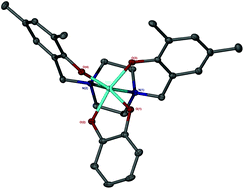Heteroleptic titanium(iv) catecholato/piperazine systems and their anti-cancer properties†
Abstract
In this paper we report the synthesis and full characterisation of a range of Ti(IV)-catecholato systems complexed to piperazine or homopiperazine salan ligands. The steric/electronic environment of the catecholate moiety has been varied and the effect this has on cytotoxicity discussed. It was observed that the 7-membered homopiperazine complexes are more stable to hydrolysis than their piperazine cousins in biological media. In general the homopiperazine complexes show higher cytotoxicity than the piperazine complexes, with the most cytotoxic complex exhibiting IC50 (μM) values of 3 ± 0.5 μM (HT-29) and 4 ± 1 μM (OVCAR).


 Please wait while we load your content...
Please wait while we load your content...